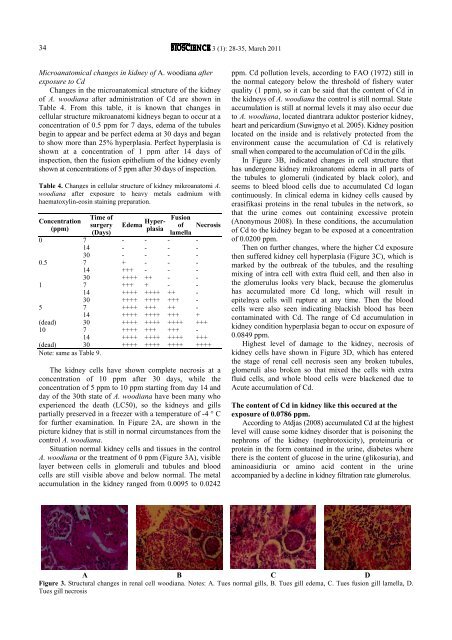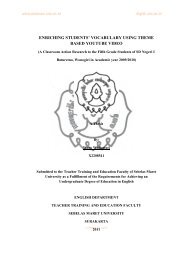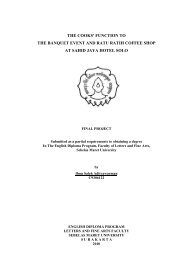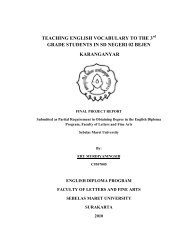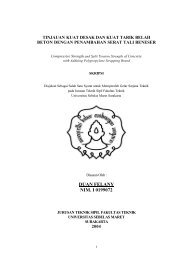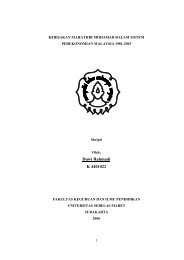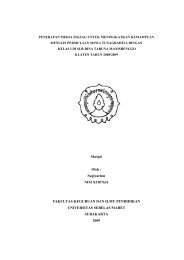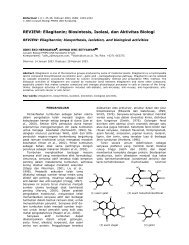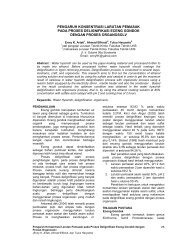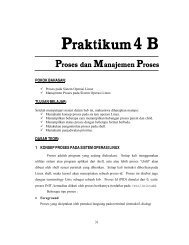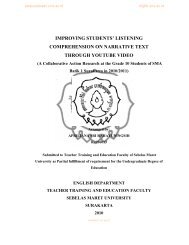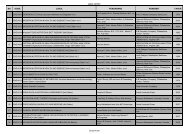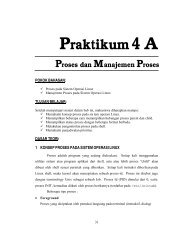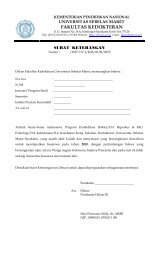ISSN 2087-3940 (PRINT) | ISSN 2087-3956 ... - Biodiversitas
ISSN 2087-3940 (PRINT) | ISSN 2087-3956 ... - Biodiversitas
ISSN 2087-3940 (PRINT) | ISSN 2087-3956 ... - Biodiversitas
You also want an ePaper? Increase the reach of your titles
YUMPU automatically turns print PDFs into web optimized ePapers that Google loves.
34<br />
3 (1): 28-35, March 2011<br />
Microanatomical changes in kidney of A. woodiana after<br />
exposure to Cd<br />
Changes in the microanatomical structure of the kidney<br />
of A. woodiana after administration of Cd are shown in<br />
Table 4. From this table, it is known that changes in<br />
cellular structure mikroanatomi kidneys began to occur at a<br />
concentration of 0.5 ppm for 7 days, edema of the tubules<br />
begin to appear and be perfect edema at 30 days and began<br />
to show more than 25% hyperplasia. Perfect hyperplasia is<br />
shown at a concentration of 1 ppm after 14 days of<br />
inspection, then the fusion epithelium of the kidney evenly<br />
shown at concentrations of 5 ppm after 30 days of inspection.<br />
Table 4. Changes in cellular structure of kidney mikroanatomi A.<br />
woodiana after exposure to heavy metals cadmium with<br />
haematoxylin-eosin staining preparation.<br />
Concentration<br />
(ppm)<br />
Time of<br />
surgery<br />
(Days)<br />
Edema Hyperplasia<br />
Fusion<br />
of<br />
lamella<br />
Necrosis<br />
0 7 - - - -<br />
14 - - - -<br />
30 - - - -<br />
0.5 7 + - - -<br />
14 +++ - - -<br />
30 ++++ ++ - -<br />
1 7 +++ + - -<br />
14 ++++ ++++ ++ -<br />
30 ++++ ++++ +++ -<br />
5 7 ++++ +++ ++ -<br />
14 ++++ ++++ +++ +<br />
(dead) 30 ++++ ++++ ++++ +++<br />
10 7 ++++ +++ +++ -<br />
14 ++++ ++++ ++++ +++<br />
(dead) 30 ++++ ++++ ++++ ++++<br />
Note: same as Table 9.<br />
The kidney cells have shown complete necrosis at a<br />
concentration of 10 ppm after 30 days, while the<br />
concentration of 5 ppm to 10 ppm starting from day 14 and<br />
day of the 30th state of A. woodiana have been many who<br />
experienced the death (LC50), so the kidneys and gills<br />
partially preserved in a freezer with a temperature of -4 ° C<br />
for further examination. In Figure 2A, are shown in the<br />
picture kidney that is still in normal circumstances from the<br />
control A. woodiana.<br />
Situation normal kidney cells and tissues in the control<br />
A. woodiana or the treatment of 0 ppm (Figure 3A), visible<br />
layer between cells in glomeruli and tubules and blood<br />
cells are still visible above and below normal. The metal<br />
accumulation in the kidney ranged from 0.0095 to 0.0242<br />
ppm. Cd pollution levels, according to FAO (1972) still in<br />
the normal category below the threshold of fishery water<br />
quality (1 ppm), so it can be said that the content of Cd in<br />
the kidneys of A. woodiana the control is still normal. State<br />
accumulation is still at normal levels it may also occur due<br />
to A. woodiana, located diantrara aduktor posterior kidney,<br />
heart and pericardium (Suwignyo et al. 2005). Kidney position<br />
located on the inside and is relatively protected from the<br />
environment cause the accumulation of Cd is relatively<br />
small when compared to the accumulation of Cd in the gills.<br />
In Figure 3B, indicated changes in cell structure that<br />
has undergone kidney mikroanatomi edema in all parts of<br />
the tubules to glomeruli (indicated by black color), and<br />
seems to bleed blood cells due to accumulated Cd logan<br />
continuously. In clinical edema in kidney cells caused by<br />
erasifikasi proteins in the renal tubules in the network, so<br />
that the urine comes out containing excessive protein<br />
(Anonymous 2008). In these conditions, the accumulation<br />
of Cd to the kidney began to be exposed at a concentration<br />
of 0.0200 ppm.<br />
Then on further changes, where the higher Cd exposure<br />
then suffered kidney cell hyperplasia (Figure 3C), which is<br />
marked by the outbreak of the tubules, and the resulting<br />
mixing of intra cell with extra fluid cell, and then also in<br />
the glomerulus looks very black, because the glomerulus<br />
has accumulated more Cd long, which will result in<br />
epitelnya cells will rupture at any time. Then the blood<br />
cells were also seen indicating blackish blood has been<br />
contaminated with Cd. The range of Cd accumulation in<br />
kidney condition hyperplasia began to occur on exposure of<br />
0.0849 ppm.<br />
Highest level of damage to the kidney, necrosis of<br />
kidney cells have shown in Figure 3D, which has entered<br />
the stage of renal cell necrosis seen any broken tubules,<br />
glomeruli also broken so that mixed the cells with extra<br />
fluid cells, and whole blood cells were blackened due to<br />
Acute accumulation of Cd.<br />
The content of Cd in kidney like this occured at the<br />
exposure of 0.0786 ppm.<br />
According to Atdjas (2008) accumulated Cd at the highest<br />
level will cause some kidney disorder that is poisoning the<br />
nephrons of the kidney (nephrotoxicity), proteinuria or<br />
protein in the form contained in the urine, diabetes where<br />
there is the content of glucose in the urine (glikosuria), and<br />
aminoasidiuria or amino acid content in the urine<br />
accompanied by a decline in kidney filtration rate glumerolus.<br />
A B C D<br />
Figure 3. Structural changes in renal cell woodiana. Notes: A. Tues normal gills, B. Tues gill edema, C. Tues fusion gill lamella, D.<br />
Tues gill necrosis


